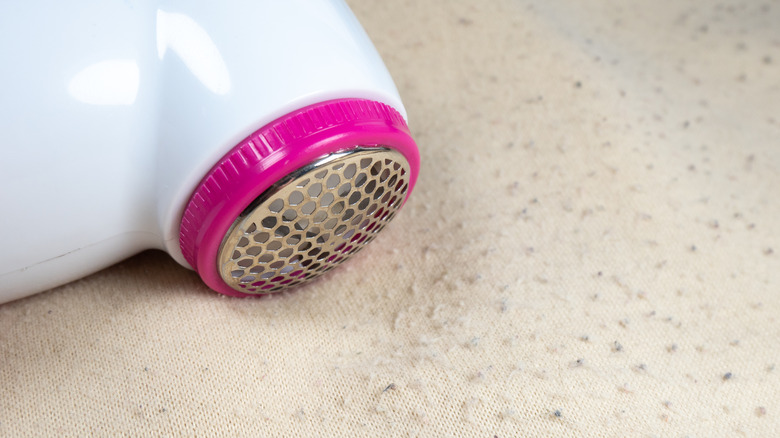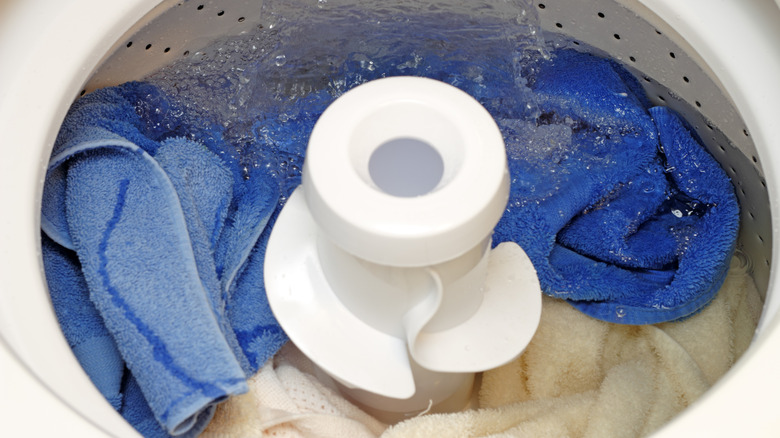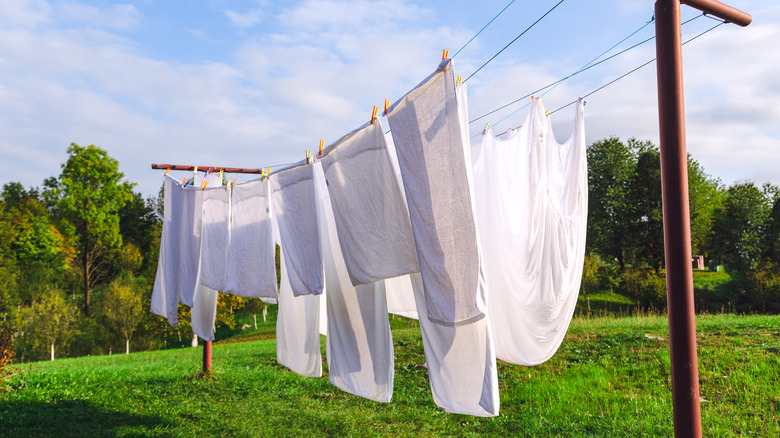How To Prevent Fuzz Balls From Forming On Your Towels
Fuzz is great when it's on a peach, the top of your baby's head, and inside sheepskin boots; not so much when it balls up and sticks like Velcro to your towels. Fuzz balls, also known as fabric pills, form when short or broken fibers tangle together and create small spheres of lint. Short-fibered materials like cotton are especially susceptible to breeding these pesky little orbs, which is why it's not uncommon for towels to suffer severe pilling. To prevent fuzz balls from forming on your towels, be strategic when loading your washer, choose laundry detergents that contain a lint-busting enzyme, and skip high heat drying.
There's no complicated scientific formula behind the formation of fuzz balls. The main culprit is simple wear and tear. During the wash cycle, towels rub up against themselves or other clothing. This continuous friction promotes fiber shedding which sets the pilling action into motion. What starts out as a few stray fibers stripped from an ordinary cotton towel quickly morphs into balls of intertwined lint. The tight knots of fuzz then fasten themselves to towels making them appear old and unattractive, and in some cases, transfer to other pieces of clothing or your body.
Washing tips
Some of the best ways to get rid of pilling on clothes are applicable to fuzz ball prevention on towels. Start by presorting laundry prior to putting it into the washing machine. You should avoid washing knitted fabrics, such as polyester and acrylic, with towels as they tend to pill aggressively and add to the loose fiber stew stirring in your washing machine. Next, wash towels on your machine's gentle cycle. This will decrease the strength and time of agitation, which in turn, reduces the number of stray fibers that may be stripped and twisted into fuzz balls. Also, given that abrading is the root cause of fuzz ball formation, it's critical that you resist overloading your washing machine. Not only will crowding intensify friction, it also interferes with agitation. Towels need ample space to move freely in order to remove dirt and debris.
To further prevent lint balls from peppering your towels, skip the bleach, which can damage fibers and intensify pilling, and select a detergent with cellulase. The enzyme is chemically designed to remove stains, but its superpowers also include loosening and detaching fuzz balls in the wash cycle. When washing towels for the first time, you can omit commercial laundry detergents altogether. Manufacturers often coat new towels with a chemical that promotes fiber molting. You can gently remove the film by washing the towels with a cup of white vinegar or one-half cup of baking soda dissolved in hot water.
Directions for drying and fuzz removal
Towels experience the same fuzz-producing friction in the dryer as they do in the washing machine; consequently, you'll want to bypass the appliance when possible. Consider line drying towels, or in cases when air drying is not an option, minimize the number of towels you place in each load to reduce abrasion. In addition, high heat can accelerate fiber shedding, so it's best to select the lowest heat setting on your dryer when natural drying alternatives are not available.
Paradoxically, a dryer can work wonders in removing fuzz balls that have already adhered themselves to your towels. Simply add a sizeable piece of nylon netting — the same material used for mesh laundry bags and laundry hamper liners — to the dryer with clean towels. The netting's plastic-based synthetic fibers rub up against fuzz balls causing them to fall off. Large fuzzies can be removed from towels with tweezers, lint rollers, fabric combs or masking tape. However, stubborn fabric pills may require an electric lint remover that uses a sharp blade to shave fuzz balls from the fabric's surface. Otherwise, you can easily mimic the same method by using a standard safety razor — minus the moisture strip — and gently hand shave fuzz balls off your favorite towels to get them looking new again.


